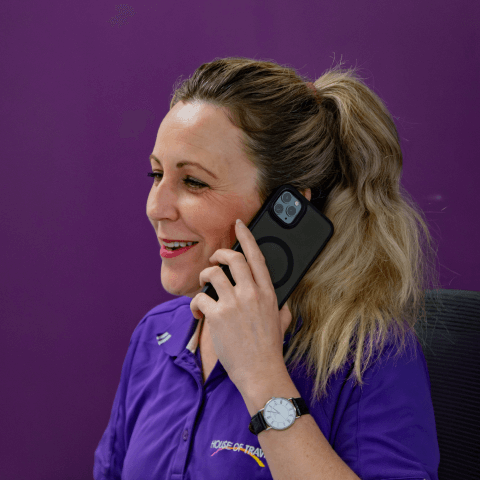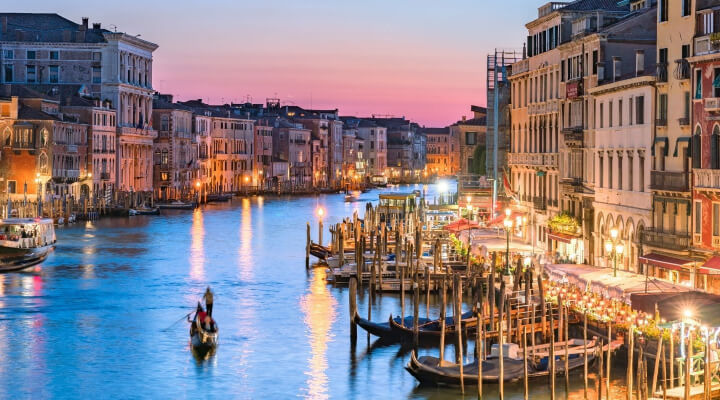Spain travel tips: What to know before you go

Thinking of Spain? Good shout. Before you dive headfirst into flamenco nights, lazy beach days and tapas galore, here’s the lowdown to help you squeeze every last drop out of your Spanish escape.
Whether it’s wandering the whimsical streets of Barcelona, bar-hopping your way through Madrid, or soaking up the sun along the Costa del Sol — Spain dishes up something magic for every kind of traveller. Our House of Travel Spain specialists have the inside scoop to help you plan a holiday that’s as rich and vibrant as the destination itself

Mild weather and mouthwatering tapas? Tick and tick. Spain doesn’t just serve up great food and good vibes, it’s a full-blown feast for the senses. You’ve got Gaudí’s dreamy curves, Picasso’s genius strokes and entire cities like Madrid and Barcelona that pulse with art, history and heart.
Even the footpaths are a stage – kids volley footballs between alleyways, while Real Madrid fans chant like it’s a religion. Culture spills out of every plaza and plate. Spain’s not just a destination, it’s a mood.
1. How long can I stay without a visa?
New Zealand citizen holders with a valid New Zealand passport are not required to obtain a visa to enter Spain, as long as they stay no more than 90 days.
2. What’s the local currency?
Euro.
3. Do I need to tip?
Unlike some other parts of Europe, tipping isn’t expected in Spain, but of course it is appreciated. You won’t always see a service charge on your bill, so if you’ve enjoyed your meal, it’s a lovely gesture to round it up or leave around 10%. It’s not compulsory, but it’ll likely earn you a warm smile and a heartfelt “gracias” on your way out.
The same goes for taxi drivers and hotel porters ... a couple of Euros will go a long way in showing your thanks.

4. Transport to and from the airport
A taxi from Barcelona–El Prat International Airport to the city should cost around 30€ - 35€, plus a surcharge of 1€ for each suitcase.
Aerobús is the fastest way to reach Barcelona's city centre on public transport. The price for a single ticket should be roughly €10. Alternatively, the subway or "metro" connects both terminals of the Airport with Barcelona. Catch the L9 Sud line from both terminal 1 and 2.
Say no to public transport. We guarantee after a 24+ hour flight from NZ, you won't want to deal with a transfer via trains and buses. Ask your HoT consultant about booking a transfer before you even leave NZ.
5. Getting around
Uber: Have met a considerable amount of resistance in Spain. Ubers can be sought in a few cities. But taxis are widely available across Spain.
Public transport: Is readily available across Spain, but be aware that services are hugely reduced on Sundays and public holidays.
6. Weather: What can you expect when you go?
Being in the northern hemisphere, the climate generally gets warmer the further south you travel. If you’re looking to visit out of season, the south and east coast is a fairly reliable year-round bet, with a lovely Mediterranean climate. Because it’s located on a plateau, Spain’s interior stays mostly hot and dry throughout the year.

7. Top 10 phrases
- Hola – Hello
-
Adiós – Goodbye
-
Por favor – Please
-
Gracias – Thank you
-
Si – Yes
-
No – No
-
Perdón – Excuse me
-
No hablo español – I don’t speak Spanish
-
¿hablas inglés? - Do you speak English?
-
Tiene? - Do you have?
8. Rules and customs
Siesta! Most people know the Spaniards love a siesta but the timings of such can be a little ambiguous. School children might leave at midday and return by 2pm, whereas businesses might not even close until 3pm – and reopen at 5pm.
Shop closures: Most shops outside major cities will close between 2pm and 5pm and many are likely to reopen come nightfall, and remain so until 8pm or 9pm.
Dining times: In Spain, evening meals don’t usually commence until at least 9pm, so if you want a restaurant with an atmosphere, hold on. If you’re looking for a little solitude (or peace and quiet) be the first through the door at six.
Holy Week: The week before Easter (the Holy Week in Spain), the annual tribute of the Passion of Jesus Christ is celebrated by Catholic religious. As the biggest religious celebration of the year, locals perform penance processions on the streets of almost every Spanish city. Watch elaborate reenactments for hours on end, including a giant cross carried through the streets atop an elaborate float.

9. Where to have fun
Work off all the churros you’ve gobbled in Barcelona and take a day hike to the Montserrat Mountain range. Roughly 50km out of the city, hire a guide and spend six hours winding through craggy mountainside, much of which resembles animals and objects. Look out for the cat, elephant and a pregnant woman.
Real Madrid has got to be one of the most famous football clubs in the world. Every player the world over dreams of walking down the players’ tunnel at Santiago Bernabéu Stadium; Real Madrid's home stadium.Take a self-guided tour of this impressive, 81,000 seater giant.
Also keep a keen eye out for The MadrEAT food fair, which takes place in the middle of Madrid’s Financial District. You’ll find traditional Spanish stews, Colombian arepas and a stand selling vermut - the Madrileños wouldn't dream of drinking anything but!
Art lovers will be in heaven in Madrid, with the largest art gallery in the world. The Prado, Reina Sofia - Spain's national museum of 20th-century art, and the Thyssen-Bornemisza Museum which houses artwork from up to five centuries prior.
10. What to do in an emergency
Spain is generally a very safe place to travel – but when it comes to pickpocketing, especially in big cities like Barcelona, the locals will tell you: these thieves are pros. The subway is a hotspot, and if someone bumps, grazes or distracts you, it might not be by accident.
Pickpockets work fast and often in teams, using distraction as their main trick – think adorable kids, lost-looking tourists, or overly helpful locals. It’s not nice, but it’s common. Stay alert, keep your bag close and zipped, and don’t make it easy for them.
A few simple tips:
- Don’t carry all your valuables in one place
- Keep your bag in front of you on public transport
- Scan and save key documents (passport, credit card, licence) on your phone
- Back them up in the Cloud or your email, just in case
The good news? Spain has four different types of police and an excellent emergency line – just dial 112 if you ever need help.
11. Mobile usage – to roam or not to roam?
Spain has four network operators:
- Movistar
- Vodafone
- Orange
- Yoigo
If your phone is unlocked, a contract-free SIM card will be a useful investment. Pricing is competitive and short-term visitors can pick up a pretty good deal. For example, Vodafone starts from as little as €15 ($24) which includes 50 minutes and 4GB of data.
If you have the time, shop around and find a deal that won't even be half the price of your NZ data roaming charges.


12. HOT’s top 5 Spanish eats
1. Paella: Originating from Valencia, Paella consists of stock flavoured rice and (traditionally) a mix of chicken, rabbit, snails and beans. But these days there are over 200 variations.
Try it: The Central Market of Valencia. Work up an appetite perusing the extensive food stalls and then fill up on fresh paella – straight from the chargrilled pan.
Address: Plaça de la Ciutat de Bruges, s/n, 46001 València.
2. Gazpacho: AKA the cold soup. Gazpacho is usually tomato based, full of vegetables and served cold. The perfect hot-weather soup.
Try it: Viridiana Restaurant. Chef Abraham Garcia's restaurant is located in the Retiro district, in central Madrid.
Address: Calle de Juan de Mena, 14 , 28014 Madrid.
3. Jamón ibérico: Jamón ibérico is well regarded as the most silky and deeply delicious of all Spanish raw ham. Sought from the Black Iberian Pig (cerdo negro), the Spanish claim it's the only breed to feed on acorns resulting in the rich flavours of the meat.
Try it: Jamón Jamón. With two specialised stores in Barcelona (in Les Corts as well as in Poble Nou District) pick up all your gourmet ham products here.
Address: Carrer d’ Europa, 23 (Barcelona). Con Gandesa, Les Corts.
4. Churros con chocolate: Predominately long strips of donut, sugared and then drizzled in chocolate sauce (and they’re not shy with the sauce either). Need we say more.
Try it: Chocolatería San Ginés. The churros are served hot and fresh, ready for dunking into the thick, dark and wonderfully gloopy pot of chocolate. Aim to sit outside, although a word of warning, your wait time may exceed an hour.
Address: Pasadizo San Ginés, 5, 28013 Madrid.
5. Callos a la Madrileña: Do you dare? Callos is a 15th century stew common across Spain but notably Madrid, consisting of beef tripe and chickpeas, blood sausage and chorizo. Can your palette handle stomach lining and blood all in one dish? If it helps, the Spanish love it. And have done for 700 years.
Try it: Sobrino de Botín, founded in 1725 and located near the Plaza Mayor.
Address: Calle Cuchilleros, 17, 28005 Madrid.
13. Is the water safe to drink?
Unless you see "Agua no potable", tap water is safe to drink in all major Spanish cities and resorts. If you’re travelling anywhere very remote, err on the side of caution and buy bottled.

14. HOT’s top insider tips
1. The world's oldest restaurant: In Madrid, eat at the 200+ year old restaurant which specialises in Suckling Pig in Madrid, near the Plaza Mayor. It's called Restaurante Botin: Calle Cuchilleros, 17, 28005. The claim to fame is mostly that it has never closed since first opening centuries ago.
2. Consider a City Bus Tour: A good option for getting around if you don’t want to walk but would prefer to give the metro a miss. These are great tours to do when you first arrive in a city to get your bearings and see the sights. On-board there are headphone jacks so you can choose your language.
3. Authentic Spanish weekends: As well as tourists, the locals also head to The San Miguel Market at Plaza de San Miguel in Madrid. It boasts dozens of food vendors all under the one glass roof. Patisseries and meat vendors (try a 'cone of meat') as well as tapas, yoghurt stalls and coffee shops. We recommend the Portuguese egg tarts, wine, beer, Sangria and Argentinian empanadas. Everything you could want in one place - if not a wee bit pricey.
4. Go in seek of ‘Ginger’ A cosy, unspoilt and relatively undiscovered Spanish bar in the heart of Barri Gótic; Barcelona's Old Town. Serving classic cocktails, fresh tapas, jazz and of course, Cava, its dimly lit interior is undisputedly seductive. Order an aperitif and give into its Catalan charm.
5. World famous Prado: The Prado/ Museo del Prado in Madrid. Visit after 6pm and entry is free. However, this only allows a few hours for viewing, whereas on average, most people spend over four. Thyssen-Bornemisza Museum is opposite The Prado, so nip across the road and visit two spectacles in one day.
6. Not a fan of running from bulls? The Spanish city of Mataelpino (roughly 50km from Madrid) has swapped its bulls for over-sized balls. The Running of the BALLS. Of course, Spain is well known for its bull runs. Notoriously so. But this event, which solely uses gigantic rolling balls, is just as much fun for the bulls as it is the participants - notably because the bulls get to stay in a field.
7. Nip to Andorra: The tiny Pyrenees-based principality that nestles inconspicuously between France and Spain. Three hours from Barcelona, in summer it’s a mecca for shopping, with over 2000 shops. While in winter, the skiing is said to be the best in the world.
8. Visit Game of Thrones' Dragonstone in real life: If you'd like to traverse the same long and windy stone paths where Daenerys Targaryen tried (and failed) to get Jon Snow to bend the knee, Dragonstone is actually Spain's San Juan de Gaztelugatxe. A small island in Basque Country complete with narrow stone bridge and all those steps. Climb to the top and you'll find a small church, where you can ring a bell and make a wish.
15. What adapter do I need?
Mains voltage is 220-240 volts AC (50 cycles) and all sockets take small round two-pin plugs.
Ready to experience the vibrant culture and flavours of Spain? Get in touch with one of our Spain specialists today!
More Europe travel blogs
Best. Holidays. Ever!
Start here
Let us help you find the perfect holiday or deal. Here’s how to get in touch...

Want the inside word on all things travel?
Never miss a deal again. Sign up for our emails and get exclusive flight offers, travel tips, and be the first to know about special promotions.
By signing up, you have read or have an opportunity to read the Privacy Policy, and you agree to the provisions of the Privacy Policy.

Thanks for signing up, we’ll be in touch soon!
Hold on a sec, adventurer! We didn't quite catch your email. Sign up again to unlock your travel dreams!





































